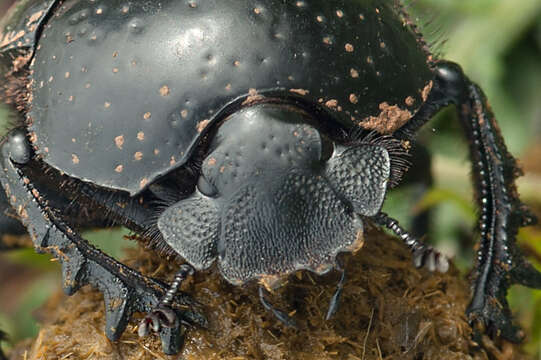Scarabaeus-sacer_3

Description:
Scarabaeus sacer Lin., syn.: Ateuchus retusus Brull, Scarabaeus europaeus Motschulsky, Scarabaeus impius FabriciusFamily: ScarabaeidaeEN: Sacred scarab beetle, DE: Heilige Pillendreher, Mistkfer Slo.: sveti skarabej, drekobrbecDat.: May 3. 2017Lat.: 45.02903 Long.: 14.66077Code: Bot_1052/2017_DSC7703 Place: Adriatic Sea, Island Krk; west of Mt. Straevnik and south of waste depo of the island Krk, Kvarner bay, Rijeka region, Croatia EC. Habitat: former fields and pastures, low grassland in patches among rocks and bushes; grazed by sheep; calcareous, skeletal ground: almost flat terrain; open, sunny, dry, hot during the summer place; average precipitations 1.400 -1.500 mm/year, average temperature 12-13 deg C, elevation 240 m (850 feet), Sub-Mediterranean phytogeographical region. Comment: The dung beetle Scarabaeus sacer was sacred to the ancient Egyptians. It was found in many old paintings and jewelry of that time. The beetles skillfully and in fierce hurry roll a peace of dung over grassland and sand ground. But this activity is not predominantly transport of the dung from place to place, as it may appear at first, but fashioning of a perfectly round ball by rolling it. Often male and female beetle work hard in tandem in a perfect coordination and mastering of equilibrium. They burry the balls after they are sufficiently firm and spherical in the ground and lay their eggs in them. Dung beetles can eat more than their own weight in a day and are therefore helpful to humans because they speed up the process of converting manure to substances usable by plants and reduce natural loss of nitrogen from the manure of the grazing cattle by burring it under the ground. Experiments have shown that the activity of these beetles on one hectare of a pasture may result in benefit of up to 130 kg of nitrogen (Ref.:2), which is essential for the fertility of the ground.Ref.:(1) Fauna Europas, Bestimmungslexikon, George Westermann Velag, Brounschweig (1997), translated to Slovenian, Mladinaka Knjiga, Ljubljana (1981), pp 384.(2) www.researchgate.net/publication/287573589_Soil_nutrient_...
Included On The Following Pages:
- Life (creatures)
- Cellular (cellular organisms)
- Eukaryota (eukaryotes)
- Opisthokonta (opisthokonts)
- Metazoa (Animal)
- Bilateria
- Protostomia (protostomes)
- Ecdysozoa (ecdysozoans)
- Arthropoda (arthropods)
- Pancrustacea
- Hexapoda (hexapods)
- Insecta (insects)
- Pterygota (winged insects)
- Neoptera (neopteran)
- Endopterygota (endopterygotes)
- Coleoptera (beetles)
- Polyphaga
- Scarabaeiformia
- Scarabaeoidea (scarab beetle)
- Scarabaeidae (scarab beetles)
- Scarabaeus
- Scarabaeus sacer
This image is not featured in any collections.
Source Information
- license
- cc-by-nc-sa
- copyright
- Amadej Trnkoczy
- photographer
- Amadej Trnkoczy
- original
- original media file
- visit source
- partner site
- Flickr Group
- ID


